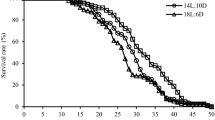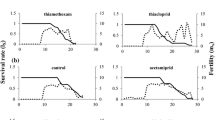Abstract
The effects of spirotetramat, a tetramic acid derivative, on gross fertility, net fertility, female longevity and the instantaneous rate of increase of two-spotted spider mite, Tetranychus urticae (Acari: Tetranychidae) were investigated after treatment of female teleiochrysalises (the first assay) and pre-ovipositional females (the second assay). Spirotetramat was applied to the leaf discs by Potter spray tower and the following series of concentrations was applied: 200, 60, 18, 5.4 and 1.62 mg/l. In both assays after 24 h of exposure, surviving females without symptoms of poisoning were used for further procedure. In the first assay, gross fertility of treated females was reduced by 2.4–64.7% and net fertility by 12.4–88.8%, compared to the control. Gross fertility of the females treated with 1.62 and 5.4 mg/l did not significantly differ from the control, whereas all concentrations, except the lowest, significantly reduced net fertility and female longevity. Treatments with 200, 60, and 18 mg/l significantly reduced the instantaneous rate of increase. In the second assay, gross fertility and net fertility were reduced by 43.7–93.3% and 73.8–98.5%, respectively. All concentrations, except the lowest, significantly reduced gross fertility, whereas net fertility and longevity in all treated females were significantly lower compared to the control. All concentrations, except the lowest, significantly reduced the instantaneous rate of increase, provided that concentrations of 200, 60 and 18 mg/l caused population decline. The effects of spirotetramat and its impact on T. urticae management are discussed.


Similar content being viewed by others
References
Bretschneider T, Fischer R, Nauen R (2007) Inhibitors of lipid synthesis. In: Krämer W, Schirmer U (eds) Modern crop protection compounds, vol 3. Wiley-VCH Verlag GmbH & Co, Weinheim, pp 909–925
Brødsgaard HF, Albajes R (1999) Insect and mite pests. In: Albajes R, Lodovica Gullino M, van Lenteren JC, Elad Y (eds) Integrated pest and disease management in greehouse crops. Kluwer Academic Publishers, Dordrecht, pp 48–60
Brück E, Elbert A, Fischer R, Krueger S, Kühnhold J, Klueken AM, Nauen R, Niebes JF, Reckman U, Schnorbach JJ, Steffens R, van Waetermeulen X (2009) Movento®, an innovative ambimobile insecticide for sucking insect pest control in agriculture: biological profile and field performance. Crop Prot 28:838–844
Cantoni A, De Maeyer L, Izquierdo Casas J, Niebes J-F, Peeters D, Roffeni S, Silva J, Villalobos A (2008) Development of Movento® on key pests and crops in European countries. Bayer CropScience J 61:349–376
Carey JR (1982) Demography of the twospotted spider mite Tetranychus urticae Koch. Oecologia 52:389–395
Carey JR (1993) Applied demography for biologists. Oxford University Press, Oxford, pp 1–206
Hu J, Wang C, Wang J, You Y, Chen F (2010) Monitoring of resistance to spirodiclofen and five other acaricides in Panonychus citri collected from Chinese citrus orchards. Pest Manag Sci 66:1025–1030
Kim MK, Sim C, Shin D, Suh E, Cho K (2006) Residual and sublethal effects of fenpyroximate and pyridaben on the instantaneous rate of increase of Tetranychus urticae. Crop Prot 25:542–548
Kramer T, Nauen R (2011) Monitoring of spirodiclofen susceptibility in field populations of European red mites, Panonychus ulmi (Koch) (Acari: Tetranychidae), and the cross-resistance pattern of a laboratory-selected strain. Pest Manag Sci 67:1285–1293. doi:10.1002/ps.2184
Kühnhold J, Klueken AM, de Maeyer L, van Waetermeulen X, Brück E, Elbert A (2008) Movento®, an innovative solution for sucking insect pest control in agriculture: field performance in fruits and vegetables. Bayer CropScience J 61(2):279–306
Li J, Margolies DC (1993) Effects of mite age, mite density and host quality on aerial dispersal behaviour in the twospotted spider mite. Entomol Exp Appl 68:79–86
Marcic D (2007) Sublethal effects of spirodiclofen on life history and life-table parameters of two-spotted spider mite (Tetranychus urticae). Exp Appl Acarol 42:121–129
Marcic D, Ogurlic I, Mutavdzic S, Peric P (2010a) The effects of spiromesifen on life history traits and population growth of two-spotted spider mite (Acari: Tetranychidae). Exp Appl Acarol 50:255–267
Marcic D, Mutavdzic S, Medjo I, Prijovic M, Peric P (2010b) Spirotetramat toxicity to immatures and sublethal effects on fecundity of female adults of Tetranychus urticae Koch. 13th International congress of acarology, August 23–27, 2010, Abstract Book, Recife, Brazil, pp 143–144
Nauen R (2005) Spirodiclofen: mode of action and resistance risk assessment in tetranychid pest mites. J Pestic Sci 30:272–274
Nauen R, Schnorbach HJ, Elbert A (2005) The biological profile of spiromesifen (Oberon®)—a new tetronic acid insecticide/acaricide. Pflanzenschutz Nachrichten Bayer 58:417–440
Nauen R, Reckmann U, Thomzik J, Thielert W (2008) The biological profile of spirotetramat (Movento®)—a new two-way systemic (ambimobile) insecticide against sucking pest species. Bayer CropScience J 61(2):245–277
Potter DA, Wrensch DL, Johnston DE (1976) Aggression and mating success in male spider mites. Science 193:160–161
Sabelis MW (1985) Reproductive strategies. In: Helle W, Sabelis MW (eds) Spider mites, their biology, natural enemies and control, vol 1A. Elsevier, Amsterdam, pp 265–278
Satoh Y, Yano S, Tahafuji A (2001) Mating strategy of spider mite Tetranychus urticae (Acari: Tetranychidae) males: postcopulatory guarding to assure paternity. Appl Entomol Zool 36:41–45
Stark JD, Banks JE (2003) Population-level effects of pesticides and other toxicants on arthropods. Annu Rev Entomol 48:505–519
Stark JD, Tanigoshi L, Bounfour M, Antonelli A (1997) Reproductive potential: its influence on the susceptibility of a species to pesticides. Ecotoxicol Environ Saf 37:273–279
Teodoro AV, Fadini MAM, Lemos WP, Guedes RNC, Pallini A (2005) Lethal and sub-lethal selectivity of fenbutatin oxide and sulfur to the predator Iphiseiodes zuluagai (Acari: Phytoseiidae) and its prey Oligonychus ilicis (Acari: Tetranychidae) in Brazilian coffee plantations. Exp Appl Acarol 36:61–70
van Pottelberge S, Khajehali J, Van Leeuwen T, Tirry L (2009) Effects of spirodiclofen on reproduction in a susceptible and resistant strain of Tetranychus urticae (Acari: Tetranychidae). Exp Appl Acarol 47:301–309
Wachendorff U, Nauen R, Schnorbach HJ, Rauch N, Elbert A (2002) The biological profile of spirodiclofen (Envidor®)—a new selective tetronic acid acaricide. Pflanzenschutz Nachrichten Bayer 55:149–176
Zhang Z-Q (2003) Mites of greenhouses—identification, biology and control. CABI Publishing, CAB International, Wallingford
Acknowledgments
This study was carried out as a part of the Project TR 31043 which is financially supported by the Ministry of Education and Science of the Republic of Serbia.
Author information
Authors and Affiliations
Corresponding author
Rights and permissions
About this article
Cite this article
Marcic, D., Petronijevic, S., Drobnjakovic, T. et al. The effects of spirotetramat on life history traits and population growth of Tetranychus urticae (Acari: Tetranychidae). Exp Appl Acarol 56, 113–122 (2012). https://doi.org/10.1007/s10493-011-9500-2
Received:
Accepted:
Published:
Issue Date:
DOI: https://doi.org/10.1007/s10493-011-9500-2




